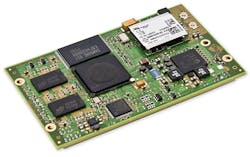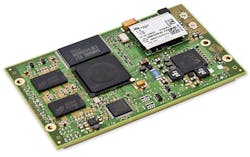Machine Learning Invades Embedded Applications (.PDF Download)
Two things have moved deep-neural-network-based (DNN) machine learning (ML) from research to mainstream. The first is improved computing power, especially general-purpose GPU (GPGPU) improvements. The second is wider distribution of ML software, especially open-source software.
Quite a few applications are driving adoption of ML, including advanced driver-assistance systems (ADAS) and self-driving cars, big-data analysis, surveillance, and improving processes from audio noise reduction to natural language processing. Many of these applications utilize arrays of GPGPUs and special ML hardware, especially for handling training that uses large amounts of data to create models that require significantly less processing power to perform a range of recognition and other ML-related tasks.
1. Digi International’s ConnectCore i.MX53/Wi-i.MX53 runs NXP’s i.MX8, which is able to handle machine-learning chores.
For example, Au-Zone Technologies’ DeepView takes advantage of the GPUs in NXP’s i.MX8. The i.MX8 is ideal for many embedded applications, and its dual GPU allows it to split video display and ML chores if necessary. The DeepView toolkit can be used for applications like industrial vision processing or ADAS. It’s optimized for the i.MX8, like the one found on Digi International’s ConnectCore i.MX53 (Fig. 1), but also works on other platforms.

